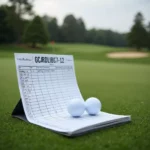When stepping onto the golf course, every golfer understands that the right ball can make a world of difference. One crucial factor that greatly influences ball performance is compression. Bridgestone Golf Balls, in particular, are known for their innovative designs tailored to enhance performance. This guide will unravel the concept of compression, especially as it pertains to Bridgestone Golf Balls, and equip you with the knowledge to select the perfect ball for your game.
What is Golf Ball Compression?
Before diving into the specifics of Bridgestone Golf Balls, let’s clarify what compression signifies in the context of golf balls. Compression refers to how much a golf ball deforms when struck by a golf club. The more a ball compresses, the greater the energy transferred to the ball, leading to a higher velocity and distance.
The Compression Scale
Golf balls typically range in compression from about 30 to 120, with the scale often being divided into three main categories:
- Low Compression (30-70): Ideal for golfers with moderate swing speeds and those seeking greater distance.
- Medium Compression (70-90): Suitable for a wide range of golfers offering a balance of distance and control.
- High Compression (90-120): Best for golfers with higher swing speeds looking for accuracy and control.
Why Does Compression Matter?
Understanding compression is crucial for selecting a golf ball optimized for your game. The right level of compression can:
- Enhance Distance: Lower compression balls tend to travel further when struck with slower swing speeds.
- Improve Control: Higher compression balls allow skilled players to control their shots with precision.
- Increase Feel: Many players appreciate the feedback from the ball on impact, which can be enhanced with the right compression.
Bridgestone Golf Balls: An Overview
Bridgestone is a long-standing name in the golf industry, known for merging technology and performance in their golf balls. They offer a range of options tailored for different players, catering to both beginners and professionals. Some popular models include:
| Model | Compression Level | Ideal Swing Speed |
|---|---|---|
| Bridgestone e12 Soft | Low (~40) | 70 mph or less |
| Bridgestone Tour B RX | Medium (~70) | 80-95 mph |
| Bridgestone Tour B X | High (~90) | 95 mph or more |
Bridgestone’s Proprietary Technology
Bridgestone employs cutting-edge technology to optimize its golf balls’ performance. Notable innovations include:
- Dual Dimple Technology: Enhances aerodynamics for improved distance.
- Gradational Compression Core: Provides a softer feel while maintaining high ball speed.
- Upper Cover Material: A softer cover, such as the one used in the e12 Soft, enhances spin control.
How to Choose the Right Compression Level
Choosing the right compression level for your game requires some self-assessment. Ask yourself:
- What is my average swing speed?
- What type of feel do I prefer during play?
- Am I more distance-focused or control-focused?
General Recommendations Based on Swing Speed
- Low Swing Speed (Under 70 mph): Opt for low compression balls like the Bridgestone e12 Soft to maximize distance and feel.
- Moderate Swing Speed (70-95 mph): Look for medium compression balls, such as the Bridgestone Tour B RX, which blend distance and control.
- High Swing Speed (95+ mph): Choose high compression balls like the Bridgestone Tour B X for better trajectory control and spin.
Testing Different Balls
An excellent way to find the perfect fit is to test different balls on the driving range or during practice rounds. Pay attention to how each ball performs in terms of:
- Distance
- Feel off the clubface
- Spin control on chips and putts
Common Misunderstandings About Compression
Myths vs. Facts
-
Myth: Only professional players should use high compression balls.
- Fact: Players of all abilities can benefit from understanding their swing speed and using appropriately compressed balls.
- Myth: Compression is solely responsible for distance.
- Fact: While compression plays a role, other factors like core construction, dimple patterns, and swing technique also influence distance.
Key Takeaways
Choosing the right compression can vastly impact your game. Here are some core tips to remember:
- Know Your Swing Speed: Understand how your swing speed determines the right compression level for your game.
- Test Various Options: Don’t hesitate to experiment with different compression levels to find what works best for you.
- Understand Ball Features: More than just compression, features like dimple design and core type can influence performance.
- Practice in Real Conditions: Always play new balls in various conditions before making a final decision.
FAQ Section
1. What is the ideal compression for beginners?
Beginners often benefit from low compression balls (e.g., Bridgestone e12 Soft) because they provide greater distance and help improve feel.
2. Can my swing speed change how a ball feels?
Absolutely. As your swing speed increases or decreases, your experience with different compression levels will change.
3. Should I use the same ball for all types of play?
It’s advisable to choose your ball based on the specific conditions (driving range, casual, tournaments), but sticking to one type can help build familiarity.
4. Is it common for pros to switch balls?
Yes, many professionals will switch ball models according to course conditions and opponents.
5. How does temperature affect golf ball performance?
Cold temperatures can harden the ball, leading to higher compression, while warm weather can soften it, affecting performance.
6. Do Bridgestone golf balls go out of stock often?
Bridgestone golf balls can experience stock shortages due to their popularity. It’s wise to buy in advance or check regularly.
7. How important is the cover material of a golf ball?
The cover material plays a significant role in spin and feel. Softer materials typically provide enhanced feedback.
8. Can I use a low compression ball for a high swing speed?
Yes, but expect different performance characteristics. It may not provide the same level of control as a high compression ball would.
9. What should I consider in windy conditions?
In windy conditions, a lower compression ball with a more stable flight path may work better to combat strong winds.
10. Can I mix different compression balls in a single round?
While possible, it’s advisable to use one compression type per round to maintain consistency in your game.
In conclusion, understanding the compression of Bridgestone Golf Balls not only aids in selecting the right ball but also enhances your overall game. By combining knowledge with practice, every golfer can find their perfect fit, leading to improved performance and enjoyment on the green. Happy swinging!

